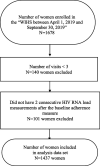Trajectories of Antiretroviral Therapy Adherence and Virologic Failure in Women With HIV in the United States
- PMID: 36804871
- PMCID: PMC10180014
- DOI: 10.1097/QAI.0000000000003174
Trajectories of Antiretroviral Therapy Adherence and Virologic Failure in Women With HIV in the United States
Abstract
Background: Women with HIV (WHIV) in the United States face many challenges with adherence to antiretroviral therapy (ART), and suboptimal adherence often leads to virologic failure. This study aimed to determine the association between ART adherence trajectories and the risk of virologic failure.
Methods: We included WHIV (aged 18 years or older) enrolled in the Women's Interagency HIV Study in the United States from April 2014 to September 2019 who had at least 2 consecutive measurements of HIV RNA and ≥3 measurements of self-reported adherence. Group-based trajectory modeling was used to identify adherence trajectories. Cox proportional hazard ratios were used to measure the association.
Main outcome measure: Virologic failure was defined as HIV RNA ≥200 copies/mL at 2 consecutive visits.
Results: We included 1437 WHIV (median age 49 years). Of all women, 173 (12.0%) experienced virologic failure. Four adherence trajectories were identified, namely "consistently high" (26.3%), "moderate increasing" (9.5%), "moderate decreasing" (30.6%), and "consistently low" (33.5%). Women in the consistently low adherence group consumed alcohol and experienced depression more than other groups. Compared with the "consistently high" trajectory, the risk of virologic failure was higher among women with "consistently low" [adjusted hazard ratio (aHR) 2.8; 95% confidence interval (CI): 1.6 to 4.9; P < 0.001] and "moderate decreasing" adherence trajectories (aHR 1.8; 95% CI: 1.0 to 3.2; P = 0.04), but it was similar to those with "moderate increasing" adherence trajectory (aHR 1.0; 95% CI: 0.4 to 2.5; P = 0.94).
Conclusions: Adherence to ART remains a challenge among WHIV. Multilevel behavioral interventions to address poor adherence, alcohol consumption, and depression are needed.
Copyright © 2023 The Author(s). Published by Wolters Kluwer Health, Inc.
Conflict of interest statement
The authors have no conflicts of interest to disclose.
Figures
Update of
-
Dual Trajectories of Antiretroviral Therapy Adherence and Polypharmacy in Women with HIV in the United States.Res Sq [Preprint]. 2023 Jan 23:rs.3.rs-2443973. doi: 10.21203/rs.3.rs-2443973/v1. Res Sq. 2023. Update in: J Acquir Immune Defic Syndr. 2023 Jun 1;93(2):162-170. doi: 10.1097/QAI.0000000000003174. PMID: 36747684 Free PMC article. Updated. Preprint.
References
-
- Centers for Disease Control and Prevention. Estimated HIV incidence and prevalence in the United States, 2015–2019. HIV Surveill Supplemental Rep. 2021;26. Available at: http://www.cdc.gov/hiv/library/reports/hiv-surveillance.html. Accessed April 12, 2022.
-
- Kassaye SG, Wang C, Ocampo JMF, et al. . Viremia trajectories of HIV in HIV-Positive women in the United States, 1994–2017. JAMA Netw Open. 2019;3:e193822. Available at: https://jamanetwork.com/journals/jamanetworkopen/fullarticle/2733428. Accessed August 5, 2022. - PMC - PubMed
-
- Benson C, Wang X, Dunn KJ, et al. . Antiretroviral adherence, drug resistance, and the impact of social determinants of health in HIV-1 patients in the US. AIDS Behav. 2020;24:3562–3573. - PubMed
Publication types
MeSH terms
Substances
Grants and funding
- P30 AI050409/AI/NIAID NIH HHS/United States
- U54 AG062334/AG/NIA NIH HHS/United States
- U01 HL146245/HL/NHLBI NIH HHS/United States
- K24 MH114732/MH/NIMH NIH HHS/United States
- P30 MH133399/MH/NIMH NIH HHS/United States
- U01 HL146192/HL/NHLBI NIH HHS/United States
- U01 HL146242/HL/NHLBI NIH HHS/United States
- U01 HL146193/HL/NHLBI NIH HHS/United States
- T32 AI007433/AI/NIAID NIH HHS/United States
- P30 AI060354/AI/NIAID NIH HHS/United States
- U01 HL146194/HL/NHLBI NIH HHS/United States
- U01 HL146241/HL/NHLBI NIH HHS/United States
- P30 AI027767/AI/NIAID NIH HHS/United States
- U01 HL146205/HL/NHLBI NIH HHS/United States
- P30 MH116867/MH/NIMH NIH HHS/United States
- P30 AI073961/AI/NIAID NIH HHS/United States
- U01 HL146201/HL/NHLBI NIH HHS/United States
- U01 HL146204/HL/NHLBI NIH HHS/United States
- U01 HL146202/HL/NHLBI NIH HHS/United States
- UL1 TR001881/TR/NCATS NIH HHS/United States
- UL1 TR000004/TR/NCATS NIH HHS/United States
- U01 HL146203/HL/NHLBI NIH HHS/United States
- UL1 TR003098/TR/NCATS NIH HHS/United States
- P30 AI050410/AI/NIAID NIH HHS/United States
LinkOut - more resources
Full Text Sources
Medical
Miscellaneous




